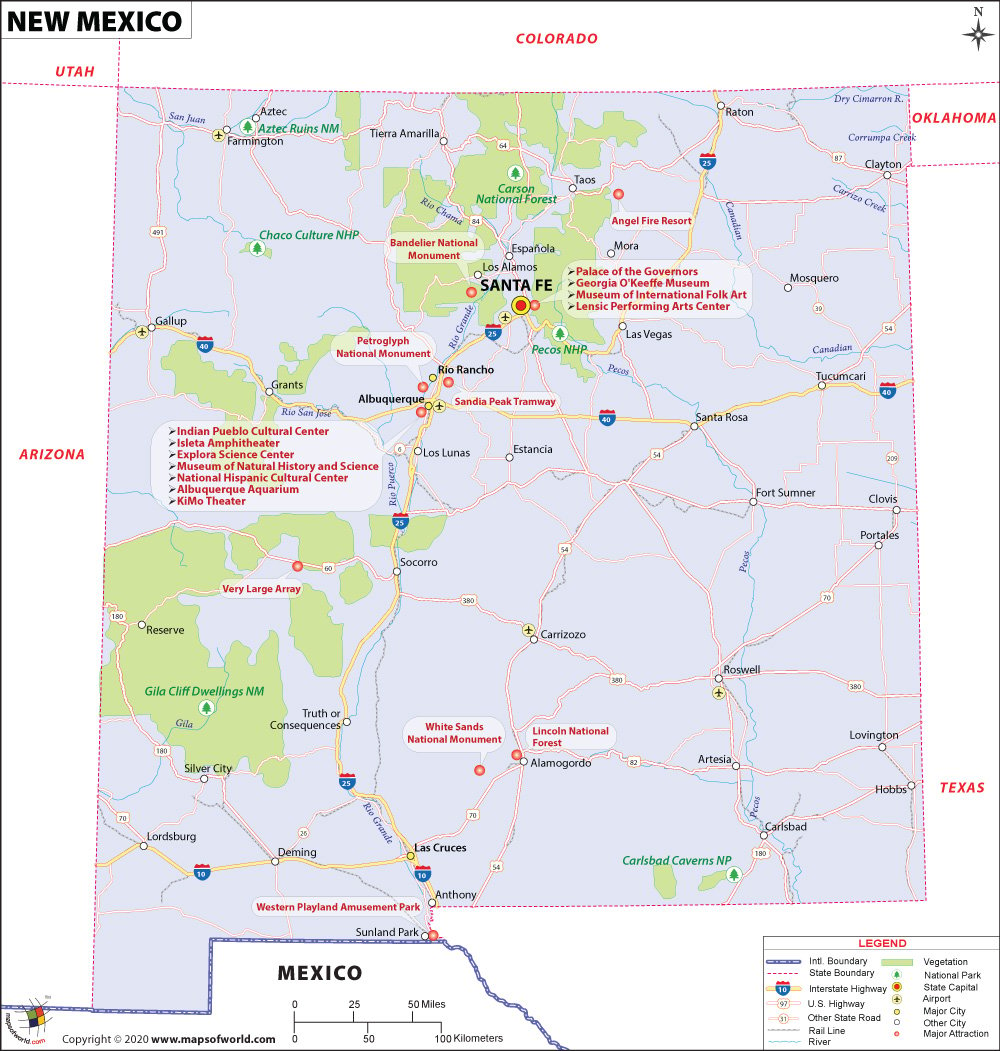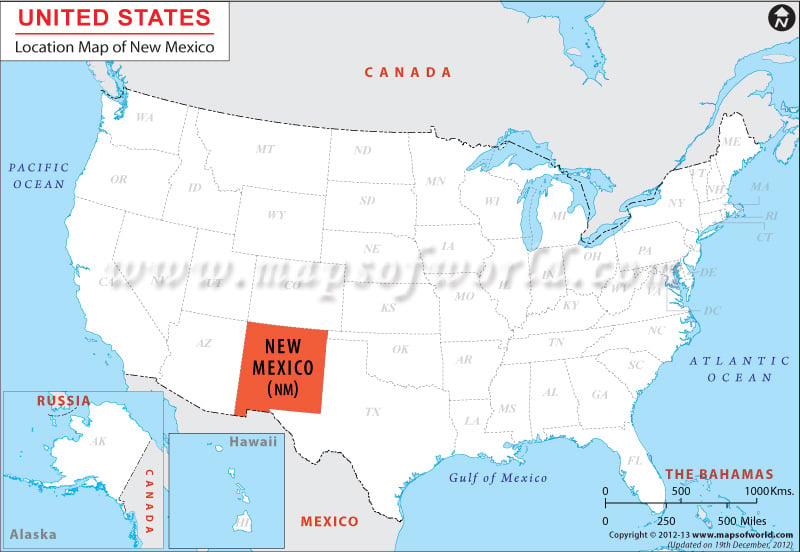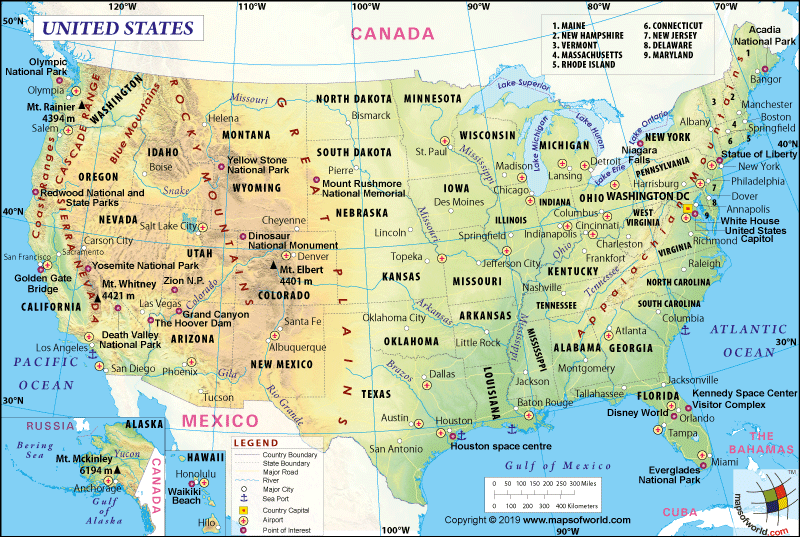What are the Key Facts of New Mexico?

|
State |
New Mexico |
|
State Capital |
Santa Fe |
|
Largest City |
Albuquerque |
|
Coordinates |
34°N 106°W |
|
Nickname(s) |
“Land of Enchantment” |
|
Postal Abbreviation |
NM |
|
Area |
121,700 sq. mi (315,199 sq. km) |
|
Highest Point |
Wheeler Peak, 13,168 ft (4,013.4 m) |
|
Number of Counties |
33 Counties, including one consolidated city-county government |
|
Neighboring States |
Colorado, Texas, Oklahoma, Arizona, Utah |
|
Population |
2,096,829 (2019) |
|
Date of Entering the Union |
January 6, 1912 |
|
State Anthem |
“O Fair New Mexico” and “Así Es Nuevo México” |
|
Governor |
Michelle Lujan Grisham (Democratic Party) |
|
Lieutenant Governor |
Howie Morales (Democratic Party) |
|
U.S. Senators |
Tom Udall (Democratic Party), Martin Heinrich (Democratic Party) |
|
U.S. House Delegation |
Deb Haaland (Democratic Party), Xochitl Torres Small (Democratic Party), Ben Ray Luján ( Democratic Party) |
|
GDP (Millions of Dollars) |
100297 |
|
Demonym |
New Mexican |
|
Time Zones |
all of state (legally) UTC-07:00 (Mountain), Summer (DST) UTC-06:00 (MDT); Nara Visa (informally) UTC-06:00 (Central), Summer (DST) UTC-05:00 (CDT) |
Where is New Mexico?
New Mexico (the 47th state that was admitted to the union on January 6, 1912) is located in the southwestern region of the USA. It shares its border with Colorado (to the north), Texas (to the south and east), Oklahoma (to the east), Arizona (to the west), and the international border with Mexico (to the south).
What is the Geography of New Mexico?
New Mexico is spread across a total area of 121,700 sq. mi (315,199 sq. km), making it the 5th largest state out of the total 50 US states. Out of the total area, the land area is spread across 121,357 sq. mi (314,591 sq. km) and the water area across 221 sq. mi (601 sq. km). New Mexico is around 370 miles (595.5 km) long from north to south. From east to west, it is around 343 miles (552 km) wide.
Water bodies occupy just 0.2% of the total area. The longest rivers in the state are Rio Grande, Pecos River, Canadian River, Cimarron River, Gila River, San Juan River, Rio Puerco, Puerco River, San Francisco River, Carrizo Creek, etc. The major lakes in New Mexico are Elephant Butte Lake, Navajo Lake, Caballo Lake, Conchas Lake, Abiquiu Lake, Brantley Lake, Santa Rosa Lake, El Vado Lake, Cochiti Lake, and Fenton Lake.
The mean elevation of New Mexico is 5,700 ft (1737.4 m) above sea level. While Wheeler Peak is the highest elevation point at 13,161 ft (4,011.5 m) above sea level, the Red Bluff Reservoir is the lowest elevation point at 2,842 ft (866.2 m) above sea level.
The major mountains in New Mexico are Wheeler Peak, Mount Walter, Old Mike Peak, Simpson Peak, Peak 12819, Lake Fork Peak, Venado Peak, Latir Peak, and Gold Hill (Taos Mountains); Truchas Peak, Middle Truchas Peak, Medio Truchas Peak, North Truchas Peak, Peak 12880, Chimayosos Peak, Jicarita Peak, and Jicarita Peak-South Peak (Santa Fe Mountains); and Big Costilla Peak, Vintrero Benchmark, and Big Costilla Peak-North Peak (Culebra Range).
The topography in New Mexico can be divided into 3 zones: the Rocky Mountain zone, the plains, and the intermountain plateau. The largest part of the state’s topography is covered by the plains. It runs from the eastern border, which is located to the western side of the first range of the mountains extending southwards from the Sangre de Cristos to the Guadalupe Mountains.
The second-largest part of the landform is covered by the Rocky Mountain zone, extending through New Mexico’s north-central zone. The third major topographic feature of New Mexico, the intermountain plateau, covers the remainder of the state.
The most memorable landform in New Mexico is the mountainous landscape. Except for a handful of countries, these mountains are seen from all the countries on the extreme eastern border. These mountains affect the climatic conditions in most parts of New Mexico. In all quadrant of the state, snow peaks can be found around the year.
There are two parts of the Great Plains found in New Mexico. While in the northeast corner of the state, the lava-capped uplands are found. The stalked plains called the Llano Estacado are roughly bounded by the Pecos River, an (imaginary) line joining Hobbs and Roswell, and the Interstate-40 highway. There are other areas that come within this plain and they are the desert (in the southern part of the state that extends from Lordsburg to Las Cruces), the plateau region in the northwest part, and various basins. The valley region includes the Plains of San Agustin as well as the Tularosa and Estancia valleys.
What is the Climate of New Mexico?
New Mexico has a semiarid to an arid climate. However, in certain areas, alpine and continental climates are also found. The presence of mountain ranges, high plains, and deserts throughout the state affects the climatic condition. In eastern parts of the state, the Great Plains or the High Plains are situated.
The average annual precipitation level of New Mexico is 13.9 inches (350 mm). The monthly average temperature reaches its peak during the summer season. The highest temperature is found in the southern areas, mainly including Albuquerque and Las Cruces.
The average annual temperature in the northeast mountains (64 °F or 18 °C) varies from that of the southeast parts (40 °F or 4 °C). The daytime temperature during summertime at less than 5,000 feet (1,500 m) elevation often goes above 100 °F (38 °C). In the month of July, the average high temperature in lower elevation areas hovers around 97 °F (36 °C). However, at the higher elevations, the average high temperature in July hovers around 78 °F (26 °C).
The nighttime temperature during the colder months (starts in November and continues till March) comes down to around zero. Most parts of New Mexico get absolutely clear skies. That’s the reason why some of the major observatories are present in this state such as the Magdalena Ridge Observatory, the Very Large Array, and the Apache Point Observatory.
What is the Economy of New Mexico?
The New Mexican economy is dependent upon the production of gas and oil, spending of the Federal government, and tourism. The total Gross Domestic Product (GDP) for New Mexico increased from US$83,724.2 million in 2008 to US$100,296 million in 2018. The Per Capita Personal Income in the state has risen from US$83,724 in 2008 to US$100,296 million in 2018. In New Mexico, the Real Median Household Income saw lots of ups and downs. In 2008, it was US$49,223. However, in one decade, it came down to 48,283 in 2018.
In terms of exports, imports, and trade balance, New Mexico’s rank in 2018 was 43, 47, and 10 respectively. The state’s value of exports was $3,656,825,525, followed by $2,601,768,141 value of imports. New Mexico has a positive trade balance of $1,055,057,384.
The major exports of New Mexico are Electrical Machinery, Industrial Machinery, Precision Instruments, Plastics, Aircraft, Chemical Products, Dairy Products, Iron & Steel Articles, Iron & Steel, and paper. The major imports are Industrial, Electrical Machinery, Precision Instruments, Pharmaceuticals, Plastics, Live Animals, Iron & Steel Articles, Furniture, Chemical Products, plastics, etc.
The rate of unemployment started increasing rapidly during the 2007-2008 US recession. It increased sharply from 3.8% in October 2007 to 7.8% in October 2009 and peaked at 8.3% in May 2010. However, it has come down gradually since then to 4.7% in December 2019.
New Mexico has one of the highest poverty rates out of the 50 US states. In 2018, the poverty rate was 19.7%. The number of people living below the poverty line in 2018 was 401,755, out of the total population of 2,044,187.
What is the Transportation System of New Mexico?
The particular location of New Mexico makes it an important trade and migration corridor. There are 3 major interstate highways present in the state Interstate 10, Interstate 25, and Interstate 40. There are fifteen US Highways that are present in the state and they are US 54, US 56, US 60, US 62, US 64, US 70, US 82, US 84, US 87, US 160, US 180, US 285, US 380, US 491, and US 550.
Throughout the New Mexico state, there are around 412 state roads, crisscrossing across thirty-three counties of the state. These state highways are around 7,405.762 miles (11,918.419 km) long. While New Mexico State Road 120 (NM 120) is the longest state highway with a length of 119.031 miles (191.562 km), NM 446 is the shortest one with a length of just 0.250 miles (402 m).
The major state highways in New Mexico are NM 44, NM 6, NM 10, NM 120, NM 9, NM 371, NM 104, NM 317, NM 55, NM 39, and many more.
The New Mexico Rail Runner Express is the major mass transit system, majorly serving the Albuquerque region, from Belen to downtown Santa Fe. The major passenger carriers in the state are Amtrak (AMTK), Cumbres and Toltec Scenic Railroad, and New Mexico Rail Runner Express (NMRX).
The common freight carriers in New Mexico are Arizona Eastern Railway (AZER), BNSF Railway (BNSF), Southwestern Railroad (SW), Texas and New Mexico Railroad (TXN), and Union Pacific Railroad (UP). There are two freight carriers too and they are Escalante Western Railway and Navajo Mine Railroad.
The major airports in New Mexico are Albuquerque International Sunport (in Albuquerque), Santa Fe Regional Airport (in Santa Fe), Roswell International Air Center (in Roswell), Lea County Regional Airport (in Hobbs), Grant County Airport (in Silver City), Clovis Municipal Airport (in Clovis), Cavern City Air Terminal (in Carlsbad), etc.
Why New Mexico is called the “Land of Enchantment”?
The “Land of Enchantment” is the official nickname of New Mexico. It got this nickname to describe the scenic beauty along with the rich history of the state. This nickname first appeared on the license plates in 1941. However, the “Land of Enchantment” nickname became the official nickname of the state on April 8, 1999.
The other nicknames of New Mexico are “The Cactus State”, “The Spanish State”, “The Land of Sunshine”, “The Land of the Delight Makers”, “The Land of Opportunity”, “The Land of the Heart’s Desire”, and many more.
What are the Popular Tourist Attractions in New Mexico?
Carlsbad Caverns National Park, White Sands National Park, Albuquerque International Balloon Fiesta, Bandelier National Monument, Petroglyph National Monument, Taos Pueblo, Cumbres-Toltec Scenic Railway, Gila Cliff Dwellings National Monument, Taos Ski Valley, Pecos National Historical Park, The Very Large Array, Chaco Culture National Historical Park, Billy the Kid Museum, Wheeler Peak Wilderness, International UFO Museum and Research Center, and many more.
Facts About New Mexico
1) The nickname of New Mexico is “The Land of Enchantment”. It is also known as The Spanish State and the Colorful State.
2) Prior to gaining statehood, NM was called as the New Mexico Territory. It was admitted to the Union on January 6, 1912 as the 47th state of the U.S.
3) The capital city of NM is Santa Fe and the largest city is Albuquerque.
4) New Mexico is bordered by Oklahoma, Colorado, Mexico, Texas, and Arizona.
5) The official motto is “It grows as it goes”.
6) The official flower is the Yucca.
7) The official gemstone is the Turquoise.
8) Hatch is nicknamed as the “Green Chilli Capital of the World”.
9) The most extensive river in the state is the Rio Grande and it covers the whole length of New Mexico.
10) Santa Fe is famous for being the capital city with the highest altitude. It is situated at an elevation of 7,000 feet.
11) The official reptile is the Whiptail Lizard.
12) Famous natives of the state of New Mexico include Judy Blume, Bill Daily, Greer Garson, John Denver, Demi Moore, Neil Patrick Harris, and Jim Morrison.
13) Albuquerque is famous for hosting the biggest hot air balloon fair in the world.
14) The official bird is the Greater Roadrunner.
15) Major industries of the state include manufacturing and tourism.
16) The official anthem is the “O Fair New Mexico”.
17) New Mexico is one of the Four Corner States of the U.S. The other three states are Arizona, Utah, and Colorado.
18) With an elevation of 13,161 feet, the Wheeler Peak is the tallest point in New Mexico.
19) The official mammal is the Black Bear and the official fish is the Cutthroat Trout.
20) In 1863, the frontiers of contemporary New Mexico were sketched by the Congress. Nevertheless, it was not incorporated into the United States until 1912.
Related Link:



![]()
